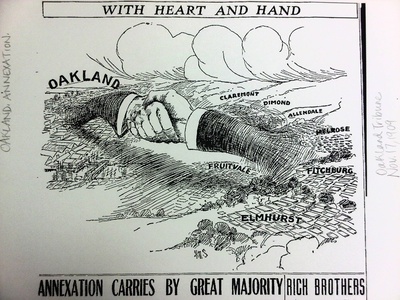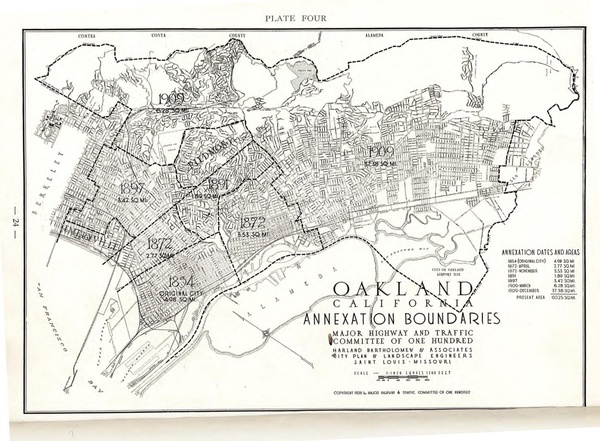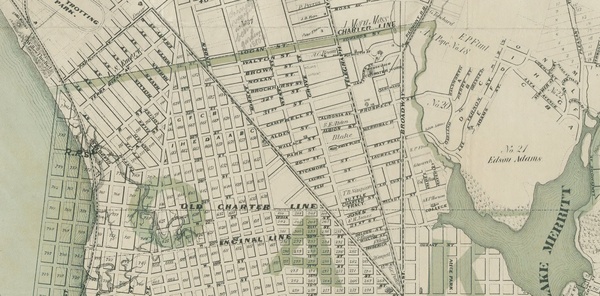When Oakland was originally incorporated, first as a town and then as a city, the boundaries were much smaller than today. Its history of annexation includes the addition of several nearby towns and unincorporated areas, plus failed annexations of Berkeley, Alameda and Piedmont.
Timeline
1852: The village of Contra Costa ("opposite shore") becomes Oakland, thanks to Horace Carpentier.
1854: By the Act entitled “An Act to Incorporate the City of Oakland,” approved March 25, 1854, Oakland changed from a “town” to a “city.” Its boundaries were described this way:
“Northerly, by a straight line drawn at right angles with Broadway, formerly Main Street, in said city, crossing the extended line of Broadway three hundred and sixty rods northerly from where stood the ‘Oak land House,’ on the northwest corner of Broadway and First Streets, and running from the bay of San Francisco, on the west, to the easterly or southeasterly line of that branch of the San Antonio Slough, or estuary, over which crosses the bridge from Oakland to Clinton; thence-along the eastern and southern highest-tide line of said slough, and of the estuary of San Antonio, following all the meanderings thereof to the mouth of said estuary, in the bay of San Francisco; thence southwesterly to ship channel; thence northerly along the line of ship channel to a point where the same intersects the said northerly boundary line extending westerly: provided, that nothing in this section contained shall be so construed as to prohibit or abridge the right of the Trustees of the town of Clinton and San Antonio, whenever the citizens thereof may elect to become a body corporate, under the provisions of any Act which may hereafter be passed, to provide for the construction of wharves and other improvements for the accommodation and convenience of the trade, travel, and commerce of the said towns or villages, at their respective sites.”5
1870: The town of Brooklyn is formed by an Act of the state legislature.
1872: Oakland annexes the town of Brooklyn.
1888: (some sources say 1892) Oakland annexes Vernon Heights (heretofore, Oakland had stayed west of Glen Echo creek)
1889: Annexation of “Berkeley, Temescal and all the adjacent territory to Oakland” proposed to Oakland Board of Trade by committees from Berkeley (including FK Shattuck) and Temescal. The Trade Board appointed a committee of Shattuck, Charles Newton and FJ Moffit to report back.6
1894: Berkeley declines to be annexed. City Council discusses the annexation of Temescal.1
1897: Piedmont Avenue area, Temescal, Golden Gate and Bushrod annexed.11,12,13 This annexation was supported by Charles Bon, Payne Shafter and Edson F. Adams, amongst others. 14
1909: Elmhurst, Fruitvale, Melrose, Fitchburg (current Lockwood) and Claremont annexed.10 The surrounding districts voted to annex themselves to Oakland. Consequently, Oakland becomes the Second Largest City in the State of California.9 This annexation brought the city’s population to 300,000. The area increased to 60.7 square miles with 27 miles of total waterfront. The assessed valuation was $125,934,476.
 Oakland Tribune, November 17 1909 hand drawn image atop article announces Annexation Vote Results from day before. ( photo taken in Oakland History Room )
Oakland Tribune, November 17 1909 hand drawn image atop article announces Annexation Vote Results from day before. ( photo taken in Oakland History Room )
Historical maps
 map of 1897 annexation 13
map of 1897 annexation 13  Map of 1909 annexation 16
Map of 1909 annexation 16
Failed annexations and secessions
At various times Oakland attempted to annex Berkeley, Alameda and Piedmont. And at least once, San Francisco wanted to annex Oakland and much of the East Bay. 15
Berkeley
In 1909, a group called the “Berkeley Consolidation League” formed in favor of the consolidation of the two cities. The league believed that “an immediate union or amalgamation of Berkeley and Oakland is the first step toward a consolidated city and county,” and that it would lead to lower taxes and higher efficiency. They asked for a few concessions: they wanted the railroad to continue into Berkeley, deep-water docks to be developed for shipping, and for Berkeley to retain its identity. This would include the name, the extension of the limits of Berkeley to 55th Street, and the election of 3 representatives: one from each side of Shattuck Avenue and one at-large councilmember.4 In 1910, both Berkeley and Oakland held elections to determine whether Berkeley would be annexed to Oakland.2 Berkeley had attempted to stop the proceedings in Superior Court, but it turned out this was unnecessary as the consolidation/annexation was voted down. 3
Alameda + Berkeley + Piedmont - Alameda County
In 1893, Oakland considered separating from Alameda County and forming a city and county of Oakland much like San Francisco had done. According to the SF Call, January 7, 1893 ”The proposed new county line runs along the bearing of Mills Seminary road, and includes the present townships of Alameda, Oakland, the greater portion of Brooklyn, the two Berkeleys, Temescal, Piedmont, Golden Gate, Lorin and Fruitvale. The next move after the creation of the new county is the proposed consolidation of all the existing communities in the said section to form a municipality to be known as the city and county of Oakland, second of that class in the State, the first being San Francisco. It is stated that there is much dissatisfaction with the present Oakland charter, which provides for too great expenditure for clerical services, and also an excessive rate of taxation. The advantages claimed for the new system of government are the single instead of dual system of taxation, and an averaging of property values beneficial to the entire community, and to the advancement of Oakland’s interests.” 8
Many business people in Oakland were enthusiastically in favor of the idea. People in the city of Alameda were against it, because they didn’t want to be burdened with Oakland’s debts and corruption (Horace Carpentier still being fresh in people’s minds). People in Livermore were against it, unless they could become the county seat of the new (remaining) Alameda County.
A similar proposal to form a city and county of Oakland was made in 1877. 20
By San Francisco
San Francisco long saw itself in competition with New York City, and was worried about the growing size and influence of Los Angeles. In 1912, SF tried to get the Wolfe Amendment passed, in order to make a greater unified Bay Area legal under the state constitution. The amendment failed to get the needed 2/3rds vote, but even if it had passed, the individual jurisdictions would still have to vote on it. 15
Proposed Secessions from Oakland
- Montclair, 2010: Area resident Tony Morosini wrote a "My Word" in the Tribune calling for Montclair to secede from Oakland My Word: Time for Montclair to gain independence from Oakland. He proposed paying $100 million to Oakland for the purchase of its facilities in Montclair, including schools, fire stations, and the library. 17,18
- Rockridge, 2013: Although perhaps suggested by fringe members, the following circulated on the Rockridge Neighborhood Watch Yahoo! Group:
”This would be a great discussion to have in an open forum, albeit maybe not on the Neighborhood Watch. When I consider how much I pay in property taxes (1.44%!!)- compared to any other California metros (not even considering outside of CA)- and what my family gets back in public works & services- it is hard to say that the City of Oakland is doing the best it can for the residents of Rockridge.” The secretary of the Greater Rockridge NCPC replied, “Thank you for remembering the focus of this group. I’m sure Rockridge Community Online would LOVE to host a discussion of seceding from Oakland.” (connotation of capital letters left to the imagination.) 7
Borders
The original charter specified the northern boundary of Oakland as:
...a straight line drawn at right angles with Broadway, formerly Main Street, in said city, crossing the extended line of Broadway at a point three hundred and sixty rods (1.125 miles) northerly from where stood the "Oakland House," on the northwest comer of Broadway and First streets, and running from the Bay of San Francisco, on the west, to the easterly or southeasterly line of that branch of the San Antonio Slough...
Following the 1872 annexation, a new northern boundary was set:
By authority of the Act of the Legislature, approved February 1, 1872, limits on the north have been extended by a vote [March, 1872] of the citizens residing therein, so as to include the district lying south of the lands of J. Mora Moss, and a line running westerly therefrom to the Bay.
The line was approximately where I-580 now runs. The western part of the line is now part of the border with Emeryville.
Encinal Line
The Encinal Line is just south of the original charter line, although not parallel. There were apparently disputes about whether that was part of Oakland or not and/or who owned the land:
The Kate Hayes Title covers that portion of Oakland township outside of the "Encinal Line," as laid down on our map. The Supreme Court of the State has sustained a decision...
Those disputes were eventually resolved:
The death of the last of the fraudulent Oakland titles—the Kate Hayes' title—which claimed to cover all of Oakland Township outside of the old charter line, was proclaimed. On Monday, December 8th, the Supreme Court sustained the decision of Judge McKinstry, in favor of the settlers, thus forever setting the claim of Carpentier at rest.
Centennial Yearbook of Alameda County, California
[ ** needs work ** ]
Links and References
- “City Extension.” [San Jose] Evening News, November 30, 1894
- Oakland Tribune, August 26, 1910
- “COURTS MAY SETTLE CONSOLIDATION LAW.” San Francisco Chronicle, March 31, 1910; pg. 8
- “BERKELEYANS WANT IMMEDIATE UNION.” San Francisco Chronicle, December 7, 1909; pg. 8
- History of Alameda County, California: Including Its Geology …, Volume 2 Oakland: M. W. Wood, Publisher, 1883
- “Annexation: Berkeley and Temescal Want to Become a Part of Oakland.” [San Jose] Evening News, August 21, 1889
- Hat tip to @victoria_bogdan for tweeting this bit of current news
- San Francisco Call, January 7, 1893
- Annexation Carries By Great Majority - Oakland Now Second Largest In State Oakland Tribune, November 17, 1909
- Oakland’s Neighborhoods by Erika Mailman. Oakland: Mailman Press, 2005
- PANIL - Neighborhood Chronology
- Temescal in 1873, OaklandNorth
- Greater Oakland Wins the Day San Francisco Call, June 11, 1897
- Prominent Land Owners Take the Initial Step for Annexation San Francisco Call, January 31, 1897 0499.pdf
- That Time San Francisco Tried To Annex Oakland, Berkeley And Most Of The Bay Area Hoodline.com, March 2017
- Annexed Territory Will Become Part of Oakland Within a Month, San Francisco Call, November 18, 1909
- A Long Hard Road to Freedom Today in Montclair blog
- My Word: Time for Montclair to gain independence from Oakland Oakland Tribune June 10, 2010
-
A proposed plan for a system of major traffic highways, Oakland, California, 1927: for the Major Highway and Traffic Committee of One Hundred, Harland Bartholomew & Associates, page 34
-
Proposition to Divide Alameda County and Form the City and County of Oakland Oakland Daily Transcript November 23, 1877
- Why Is Piedmont a Separate City From Oakland? Bay Curious on KQED






